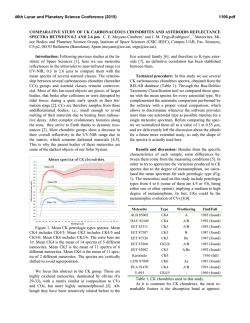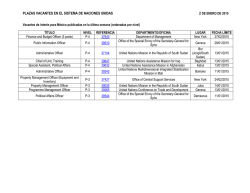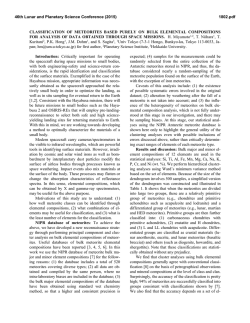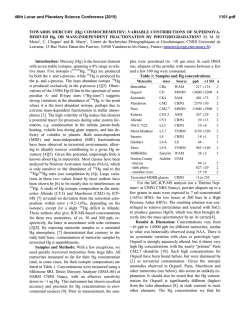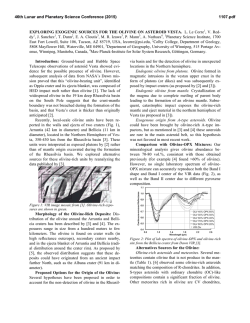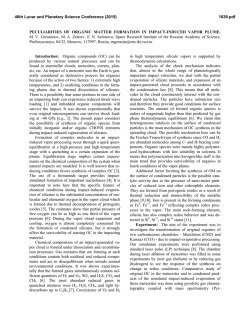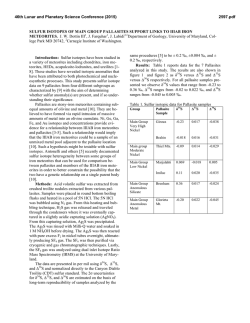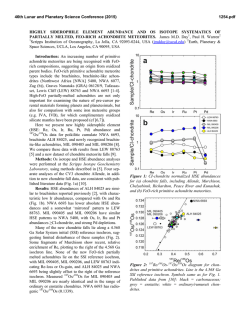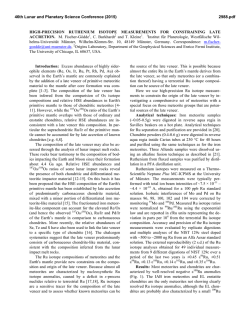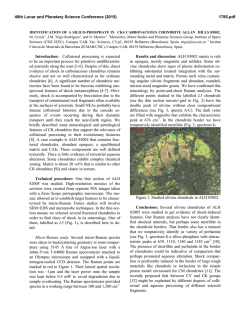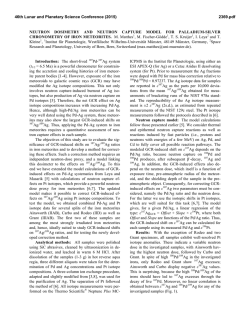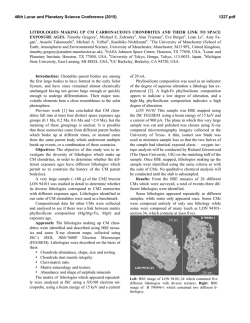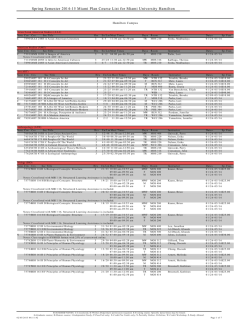
AQUEOUS ALTERATION IN CR METEORITES AS SEEN WITH VIS
46th Lunar and Planetary Science Conference (2015) 2540.pdf AQUEOUS ALTERATION IN CR METEORITES AS SEEN WITH VIS/NIR AND MIR SPECTROSCOPY. M. M. McAdam1, J. M. Sunshine1, K. T. Howard2,3, T. J. McCoy4, C. M. O’D. Alexander5, and J. Davidson5. 1Dept of Astronomy, University of Maryland, College Park MD, 20742. 2Kingsborough Community College. 3American Museum of Natural History. 4National Museum of Natural History, Smithsonian Institution. 5Department of Terrestrial Magnetism Carnegie Institution of Washington. Email: [email protected]. Introduction: Renazzo-type chondrites (CRs) are investigated here as part of coordinated spectralmineralogical study of chondrites. Here, we report preliminarily results on the visible/near-infrared (VIS/NIR) and mid-infrared (MIR) reflectance spectra of four CR meteorites. Using MIR spectroscopy, we are able to identify spectral signatures related to mineralogy and alteration state. CR chondrites contained primary abundant ironnickel metal but have undergone sometimes extensive interactions with water in their parent bodies. The extent of this alteration is highly variable between CRs, with total phyllosilicate abundances in CRs ranging from <5 vol. % (e.g. MET 00426) to >65 vol. % (e.g. Al Rais, CR1 GRO 95577) [1]. Aqueous alteration in CR meteorites is generally less extensive than in the CM and CI chondrites [1,2,3]. Additionally, differences in primary mineralogies and water abundances led to a somewhat different style of aqueous alteration in CRs than CMs [e.g. 1, 2]. The CR2 phyllosilicates are typically poorly crystalline and tend to be Fe2+-rich serpentines rather than cronstedtite in CM2s [2]. Here we show that in the MIR, the more altered CR meteorites appear to be spectrally similar to the least aqueously altered CM meteorites, while the less altered CRs are more similar to CV3 meteorites. This is consistent with the mineralogies of CRs [1]. Spectral changes between the least and most altered CRs are continuous and depend on the relative abundances of anhydrous and hydrated materials. Samples: Four CR2 meteorites are studied here: Miller Range (MIL) 090001, Miller Range 090657, Buckley Island (BUC) 10933, and Al Rais. However, BUC 10933 may be a misclassified CV meteorite similar to RBT 04133 [4]. PSD-XRD and a pattern fitting technique [1] were used to determine the modal mineralogy of all samples. For XRD analyses, 100 mg powdered samples were prepared from larger, fresh, interior chips. These were ground, by hand, to a fine powder (≤ 35um). Spectral Data Collection: After XRD, 50 mg aliquots of the same meteorite were spectrally characterized at the Brown Unv.’s NASA/Keck Reflectance Lab (RELAB) using the bidirectional spectrometer (i=30o, e=0o, resolution: 10 nm) and FTIR mid-infrared spectrometer (resolution: 4 cm-1). The data is subsequently normalized (to 1, MIR: at 8-µm; VIS/NIR at 2.4-µm). VIS/NIR Results: The VIS/NIR spectra of the four CRs show few features, even after continuum removal (Fig. 1). This result is consistent with previous work by Cloutis et al. [5]. Terrestrial weathering (Feoxyhydroxides [5]) is apparent at 0.9-µm. None of the CR meteorites have a 0.7-µm charge transfer band. To have charge transfer absorptions, there must be significant Fe2+ and Fe3+. The CRs typically have little Fe3+ in their phyllosilicates. The NIR slope (reflectance ratio at 0.56- and 2.4µm) is highly variable in the CRs studied here (Fig. 1). This is consistent with the observations of the CM meteorites [e.g. 5, 7] where NIR slope is unrelated to alteration state. MIR Results: The CR meteorites show features that are consistent with complex mixtures of anhydrous and hydrous materials (Fig. 2). A broad ~12.3-µm feature is apparent in all of the spectra due to the presence of olivine [7]. Most of the CRs have this feature with high-frequency peaks superimposed on the shortwavelength side. These superimposed features are caused by both olivine and pyroxene. The wide range in phyllosilicate content (<5 - >65 vol. %) affects the MIR spectra. As the phyllosilicate content increases, the 10-13-µm region shifts to shorter wavelengths and the feature broadens (Fig. 2). Three of the four chondrites (BUC 10933, MIL 090657 and MIL 090001) bear a striking resemblance to the CM2 meteorite Pecora Escarpment (PCA) 91008 (Fig. 2). PCA 91008 is an aqueously altered, thermally metamorphosed CM [e.g. 8, 9]. The heating after alteration caused some of the phyllosilicates present in this meteorite to become dehydroxlyated and highly disordered [8, 9]. The CR mineralogy is not a product of thermal metamorphism [e.g. 10] despite the spectral similarities with PCA 91008. For example, MIL 09657 shows no evidence of heating [10]. Furthermore, we are not implying a genetic connection between these samples. The relative abundance of olivine and pyroxene changes the shape of the superimposed features between 8.5- and ~11.85-µm (Fig. 3). When there is much more olivine in a sample (olv/pyx≥2) the ~9.5µm and 10.5-µm olivine features are much more pronounced. When the relative abundances of olv/pyx ≤ 1, the pyroxene features are more prominent (e.g. the 8.75-9.75-µm feature in MIL 090657 and MIL 09001) PCA 91008 is spectrally similar to the least altered CR meteorites in both the shape and position of the 10- 46th Lunar and Planetary Science Conference (2015) 2540.pdf 13-µm peak as well as the superimposed features on the short-wavelength side. The 10-13- µm peak is not shifted to shorter wavelengths and is not as broad as the more altered CRs (Al Rais and MIL 090001). This may be indicative that PCA 91008 is substantially less altered than other CMs, having as little as 30-40 vol. % total phyllosilicates. This will be confirmed with PSDXRD analyses. Future Work: The next steps of this project are to compare our new spectral data for these CRs to the forthcoming mineralogical data. More detailed spectral analyses will be conducted, including spectral mixture models. Samples of highly altered CR1s meteorites will also be analyzed. In addition, other meteorites will be examined in this extended coordinated VIS/NIR and MIR spectral and mineralogical study including those with little to no aqueous alteration (COs and CVs). Acknowledgements: Spectra were acquired using the NASA Keck RELAB a multiuser facility. A special thanks to T. Hiroi who collected the RELAB spectra on our behalf. Funding for this research by NASA’s PGG Program (NNX10AJ57G) is gratefully acknowledged. References: [1] Howard, K. T., et al., (2015). Geochim. Cosmochim. Acta 149, 206-222. [2] Le Guillou, C. et al., (2014) Geochim. Cosmochim. Acta, 131, 344-367. [3] Alexander, C. M. O’D. et al. (2013) Geochim. Cosmochim. Acta, 123, 244-260. [4] Davidson J. et al. (2014) MAPS 49, 21332151 [5] Cloutis, E. A., et al., (2012). Icarus, 217, 389-407. [6] Cloutis, E. A., et al., (2011). Icarus 216, 309-346. [7] McAdam, M. M., et al., (2015). Icarus, 245, 320-332. [8] Choe, W. H., et al., (2010). Meteor. & Planet. Sci.,. 45, 531554. [9] Tonui, E., et al., (2014) Geochim. Cosmochim. Acta, 126, 284-306. [10] Davidson J. et al. (2015) LPS 46 [11] Klima R. L., et al., (2007). Meteor. & Plan. Sci., 42, 235253. Fig. 1: VIS/NIR Spectra of CR meteorites (MIL 090657, offset 0.75; BUC 10933, offset 0.35; Al Rais, offset 0.25 and MIL 09001). The spectra are featureless with variable slopes. The lack of a charge-transfer band at 0.7-µm is a result of the oxidation state of the meteorites. Terrestrial weathering can be observed at 0.9-µm. Fig. 2: MIR Spectra of CRs (offset 0.5): Legend: PCA 91008 (CM2, black), MIL 09657 (pink), BUC 10933 (green), Al Rais (purple), MIL 09001 (blue), synthetic enstatite (En100, yellow [11]), San Carlos olivine (red), SCO 06043 (CM2; bottom, green, [7]). The MIR spectra of the CRs are controlled by olivine, especially the superimposed features on the short wavelength side of the 10-13-µm feature. As phyllosilicate abundances increase, the 10-13-µm feature shifts to shorter wavelengths and broadens. Additionally, the 16-25-µm region increases in reflectance and olivine features are washed out. Fig. 3: Phyllosilicate content changes 9.75-11.85-µm Slope. CV3 Kaba (top) represents a mostly unaltered meteorite. The CRs are ordered, roughly, in increasing phyllosilicate content. PCA 91008 (CM2) [7] represents a more altered meteorite. The slope in the region increases, becoming less flat with increasing hydration.
© Copyright 2026
